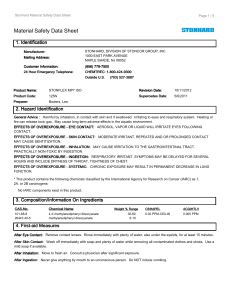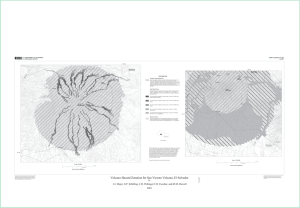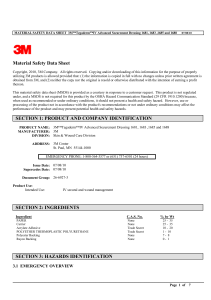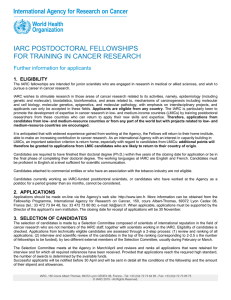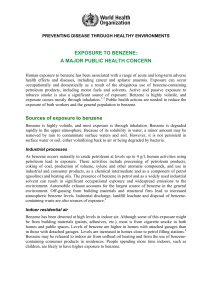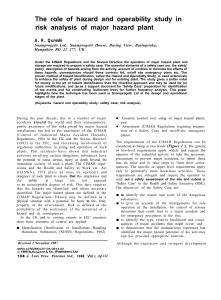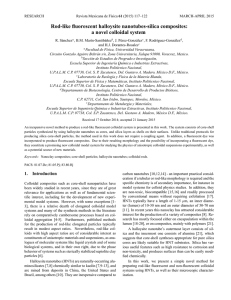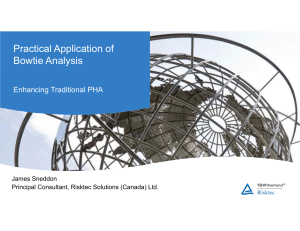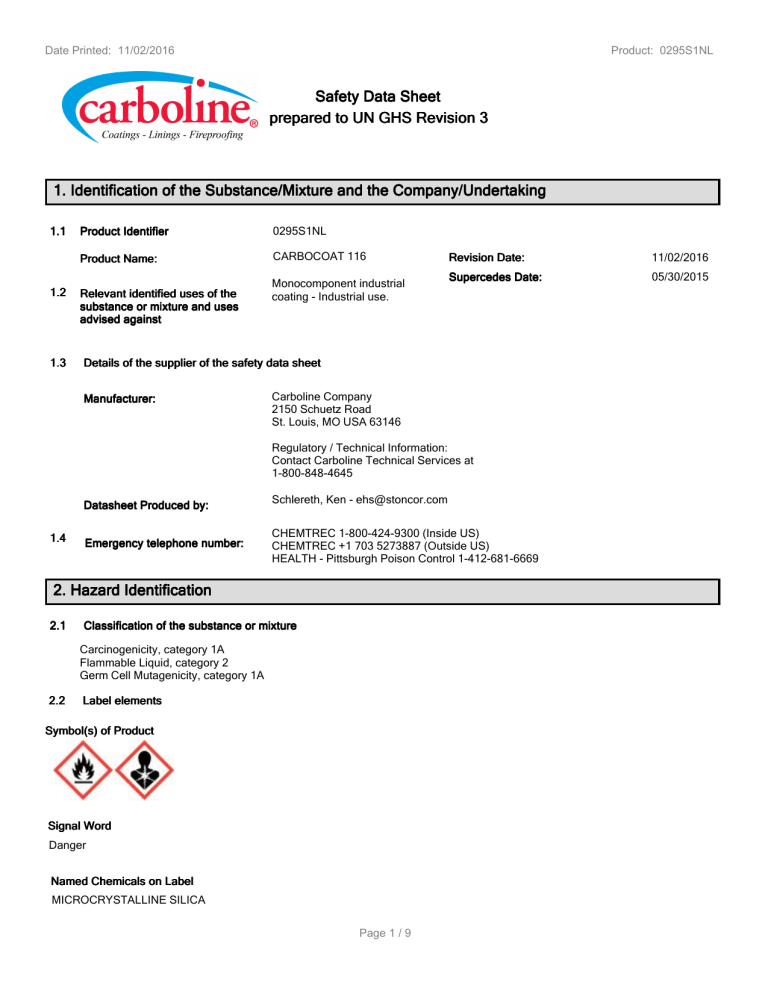
Date Printed: 11/02/2016 Product: 0295S1NL Safety Data Sheet prepared to UN GHS Revision 3 1. Identification of the Substance/Mixture and the Company/Undertaking 1.1 1.2 1.3 Product Identifier 0295S1NL Product Name: CARBOCOAT 116 Relevant identified uses of the substance or mixture and uses advised against Monocomponent industrial coating - Industrial use. Revision Date: 11/02/2016 Supercedes Date: 05/30/2015 Details of the supplier of the safety data sheet Manufacturer: Carboline Company 2150 Schuetz Road St. Louis, MO USA 63146 Regulatory / Technical Information: Contact Carboline Technical Services at 1-800-848-4645 Datasheet Produced by: 1.4 Emergency telephone number: Schlereth, Ken - [email protected] CHEMTREC 1-800-424-9300 (Inside US) CHEMTREC +1 703 5273887 (Outside US) HEALTH - Pittsburgh Poison Control 1-412-681-6669 2. Hazard Identification 2.1 Classification of the substance or mixture Carcinogenicity, category 1A Flammable Liquid, category 2 Germ Cell Mutagenicity, category 1A 2.2 Label elements Symbol(s) of Product Signal Word Danger Named Chemicals on Label MICROCRYSTALLINE SILICA Page 1 / 9 Date Printed: 11/02/2016 Product: 0295S1NL GHS HAZARD STATEMENTS EUH208 Other EU extensions Flammable Liquid, category 2 Germ Cell Mutagenicity, category 1A Carcinogenicity, category 1A GHS PRECAUTION PHRASES Contains METHYL ETHYL KETOXIME. May produce an allergic reaction. Highly flammable liquid and vapour. May cause genetic defects. May cause cancer. H225 H340-1A H350-1A P201 P202 Obtain special instructions before use. Do not handle until all safety precautions have been read and understood. Keep away from heat/sparks/open flames/hot surfaces. – No smoking. Keep cool. Wear respiratory protection. IF exposed or concerned: Get medical advice/attention Store in a well-ventilated place. Keep container tightly closed. P210 P235 P284 P308+313 P403+233 2.3 Other hazards No Information Results of PBT and vPvB assessment: The product does not meet the criteria for PBT/VPvB in accordance with Annex XIII. 3. Composition/Information On Ingredients 3.2 Mixtures Hazardous Ingredients CAS-No. 13463-67-7 64742-89-8 540-88-5 100-41-4 68953-58-2 14808-60-7 1333-86-4 149-57-5 CAS-No. 13463-67-7 64742-89-8 540-88-5 100-41-4 68953-58-2 14808-60-7 1333-86-4 149-57-5 Chemical Name TITANIUM DIOXIDE HIGH FLASH NAPHTHA TERT-BUTYL ACETATE ETHYL BENZENE ORGANOPHILIC CLAY MICROCRYSTALLINE SILICA CARBON BLACK ETHYLHEXANOIC ACID GHS Symbols GHS08 GHS02 GHS02-GHS07-GHS08 GHS08 GHS08 GHS07-GHS08 GHS08 Additional Information: % 10-25 10-25 10-25 0.1-1.0 0.1-1.0 0.1-1.0 0.1-1.0 <0.1 GHS Hazard Statements H340-350 H225 H225-315-319-332-373-412 H350-371-373 H350-372 H319-335-351-372 H361 M-Factors 0 0 0 0 0 0 0 0 The text for GHS Hazard Statements shown above (if any) is given in Section 16. 4. First-aid Measures 4.1 Description of First Aid Measures AFTER INHALATION: Give oxygen or artificial respiration if needed. Remove person to fresh air. If signs/symptoms continue, get medical attention. AFTER SKIN CONTACT: In case of contact, immediately flush skin with plenty of water for at least 15 minutes while removing contaminated clothing and shoes. If skin irritation persists, call a physician. AFTER EYE CONTACT: Rinse thoroughly with plenty of water for at least 15 minutes and consult a physician. AFTER INGESTION: Do NOT induce vomiting. Never give anything by mouth to an unconscious person. If swallowed, call Page 2 / 9 Date Printed: 11/02/2016 Product: 0295S1NL a poison control centre or doctor immediately. 4.2 Most important symptoms and effects, both acute and delayed This product may contain Carbon Black, which is listed by IARC as possibly carcinogenic to humans (Group 2B). This listing is based on inadequate evidence of carcinogenicity in humans and sufficient evidence in experimental animals. This classification is relevant when exposed to carbon black in dust or powder form only, including cured product that is subject to sanding, grinding, cutting, or other surface preparation activities. Harmful if swallowed. Irritating to eyes and skin. Risk of serious damage to the lungs (by aspiration). Vapours may cause drowsiness and dizziness. This product contains silica which is classified by IARC as a known human carcinogen (Group 1). Crystalline silica is known to cause silicosis. This product may contain Titanium Dioxide, which is listed by IARC as possibly carcinogenic to humans (Group 2B). This listing is based on inadequate evidence of carcinogenicity in humans and sufficient evidence in experimental animals. The classification(s) is/are relevant when exposed to these respirable substances in dust or powder form only, including cured product that is subject to sanding, grinding, cutting, or other surface preparation activities. 4.3 Indication of any immediate medical attention and special treatment needed No information available on clinical testing and medical monitoring. Specific toxicological information on substances, if available, can be found in section 11. When symptoms persist or in all cases of doubt seek medical advice. 5. Fire-fighting Measures 5.1 Extinguishing Media: Carbon Dioxide, Dry Chemical, Foam, Water Fog UNUSUAL FIRE AND EXPLOSION HAZARDS: Flammable liquid. Vapours are heavier than air and may spread along floors. Vapours may form explosive mixtures with air. Vapors may travel to areas away from work site before igniting/flashing back to vapor source. Provide adequate ventilation. Prevent the creation of flammable or explosive concentrations of vapour in air and avoid vapour concentration higher than the occupational exposure limits. Keep away from heat/sparks/open flames/hot surfaces. - No smoking. Electrical installations / working materials must comply with the technological safety standards. Wear shoes with conductive soles. 5.2 Special hazards arising from the substance or mixture No Information 5.3 Advice for firefighters In the event of fire, wear self-contained breathing apparatus. Cool containers / tanks with water spray. Flammable. 6. Accidental Release Measures 6.1 Personal precautions, protective equipment and emergency procedures For personal protection see section 8. Ensure adequate ventilation. Evacuate personnel to safe areas. Evacuate personnel to safe areas. Remove all sources of ignition. Remove all sources of ignition. To avoid ignition of vapours by static electricity discharge, all metal parts of the equipment must be grounded. Wear personal protective equipment. 6.2 Environmental precautions Do not allow material to contaminate ground water system. Prevent product from entering drains. 6.3 Methods and material for containment and cleaning up Prevent further leakage or spillage if safe to do so. Contain spillage, soak up with non-combustible absorbent material, (e.g. sand, earth, diatomaceous earth, vermiculite) and transfer to a container for disposal according to local / national regulations (see section 13). Contain spillage, soak up with non-combustible absorbent material, (e.g. sand, earth, diatomaceous earth, vermiculite) and transfer to a container for disposal according to local / national regulations (see section 13). 6.4 Reference to other sections Please refer to disposal requirements or country specific disposal requirements for this material. See Section 13 for further information. Page 3 / 9 Date Printed: 11/02/2016 Product: 0295S1NL 7. Handling and Storage 7.1 Precautions for safe handling INSTRUCTIONS FOR SAFE HANDLING : Keep containers dry and tightly closed to avoid moisture absorption and contamination. Prepare the working solution as given on the label(s) and/or the user instructions. Do not breathe vapours or spray mist. Ensure all equipment is electrically grounded before beginning transfer operations. Do not use sparking tools. Wash thoroughly after handling. Do not get in eyes, on skin, or on clothing. Use only with adequate ventilation/personal protection. PROTECTION AND HYGIENE MEASURES : Handle in accordance with good industrial hygiene and safety practice. Wash hands before breaks and at the end of workday. When using, do not eat, drink or smoke. 7.2 Conditions for safe storage, including any incompatibilities CONDITIONS TO AVOID: Heat, flames and sparks. STORAGE CONDITIONS: Keep container closed when not in use. Store in a dry, well ventilated place away from sources of heat, ignition and direct sunlight. 7.3 Specific end use(s) No specific advice for end use available. 8. Exposure Controls/Personal Protection 8.1 Control parameters Ingredients with Occupational Exposure Limits (US) TITANIUM DIOXIDE 10-25 HIGH FLASH NAPHTHA 10-25 ACGIH TLV- ACGIH TLVTWA STEL 10 MGM3 N/E 300 PPM N/E 500 PPM NE TERT-BUTYL ACETATE 10-25 200 PPM N/E 950 MGM3 N/E ETHYL BENZENE 0.1-1.0 20 PPM N/E 435 MGM3 N/E ORGANOPHILIC CLAY 0.1-1.0 NE N/E NE MICROCRYSTALLINE SILICA 0.1-1.0 CARBON BLACK 0.1-1.0 0.025 MG/M3 N/E (respirable) 3.0 MG/M3 N/E N/E N/E NE 0.1 MG/M3 (respirable) 3.5 MG/M3 N/E N/E Name ETHYLHEXANOIC ACID % <0.1 OSHA PELTWA 10 MGM3 OSHA PELCEILING N/E OEL Note N/E N/E FURTHER INFORMATION: Refer to the regulatory exposure limits for the workforce enforced in each country. 8.2 Exposure controls Personal Protection RESPIRATORY PROTECTION: In order to avoid inhalation of spray-mist and sanding dust, all spraying and sanding must be done wearing adequate respirator. Use only with ventilation to keep levels below exposure guidelines reported in this document. User should test and monitor exposure levels to ensure all personnel are below guidelines. If not sure, or not able to monitor, use State or federally approved supplied air respirator. For silica containing coatings in a liquid state, and/or if no exposure limits are established above, air-supplied respirators are generally not required. EYE PROTECTION: Safety glasses with side-shields. HAND PROTECTION: Gloves should be discarded and replaced if there is any indication of degradation or chemical breakthrough. Impervious gloves. Request information on glove permeation properties from the glove supplier. OTHER PROTECTIVE EQUIPMENT: Ensure that eyewash stations and safety showers are close to the workstation location. Lightweight protective clothing ENGINEERING CONTROLS: Avoid contact with skin, eyes and clothing. Ensure adequate ventilation, especially in confined areas. 9. Physical and Chemical Properties Page 4 / 9 Date Printed: 11/02/2016 9.1 9.2 Product: 0295S1NL Information on basic physical and chemical properties Viscous Liquid, Various Colors Appearance: Physical State Liquid Odor Solvent Odor threshold N/D pH N/D Melting point / freezing point (°C) N/D Boiling point/range (°C) 176 F (80 C) - 400 F (204 C) Flash Point, (°C) 10 Evaporation rate Slower Than Ether Flammability (solid, gas) Not determined Upper/lower flammability or explosive limits 0.9 - 9.5 Vapour Pressure, mmHg N/D Vapour density Heavier than Air Relative density Not determined Solubility in / Miscibility with water N/D Partition coefficient: n-octanol/water Not determined Auto-ignition temperature (°C) Not determined Decomposition temperature (°C) Not determined Viscosity Unknown Explosive properties Not determined Oxidising properties Not determined Other information VOC Content g/l: 249 Specific Gravity (g/cm3) app. 1.50 10. Stability and Reactivity 10.1 Reactivity No reactivity hazards known under normal storage and use conditions. 10.2 Chemical stability Stable under normal conditions. 10.3 Possibility of hazardous reactions Hazardous polymerisation does not occur. 10.4 Conditions to avoid Heat, flames and sparks. 10.5 Incompatible materials Strong oxidizing agents. 10.6 Hazardous decomposition products Page 5 / 9 Date Printed: 11/02/2016 Product: 0295S1NL Carbon dioxide (CO2), carbon monoxide (CO), oxides of nitrogen (NOx), dense black smoke. 11. Toxicological Information 11.1 Information on toxicological effects Acute Toxicity: Oral LD50: N/D Inhalation LC50: N/D Irritation: Unknown Corrosivity: Unknown Sensitization: Unknown Repeated dose toxicity: Unknown Carcinogenicity: Unknown Mutagenicity: Unknown Toxicity for reproduction: Unknown If no information is available above under Acute Toxicity then the acute effects of this product have not been tested. Data on individual components are tabulated below: CAS-No. Chemical Name Oral LD50 Dermal LD50 Vapor LC50 13463-67-7 TITANIUM DIOXIDE 25000 mg/kg, oral (rat) Not Available Not Available 64742-89-8 HIGH FLASH NAPHTHA Not Available 540-88-5 TERT-BUTYL ACETATE 3160 mg/kg, oral, rat Not Available 4000 ppm/6 hours, rat inhalation 100-41-4 ETHYL BENZENE 3500 mg/kg rat, oral >5000 mg/l, dermal rabbit 17.2 mg/L Inh, Rat, 4Hr 68953-58-2 ORGANOPHILIC CLAY NOT AVAILABLE 14808-60-7 MICROCRYSTALLINE SILICA 22500 mg/kg Not Available Not Available 1333-86-4 CARBON BLACK 8000 mg/kg oral, rat Not Available Not Available Not Available NOT AVAILABLE Additional Information: This product may contain Carbon Black, which is listed by IARC as possibly carcinogenic to humans (Group 2B). This listing is based on inadequate evidence of carcinogenicity in humans and sufficient evidence in experimental animals. This classification is relevant when exposed to carbon black in dust or powder form only, including cured product that is subject to sanding, grinding, cutting, or other surface preparation activities. Harmful if swallowed. Irritating to eyes and skin. Risk of serious damage to the lungs (by aspiration). Vapours may cause drowsiness and dizziness. This product contains silica which is classified by IARC as a known human carcinogen (Group 1). Crystalline silica is known to cause silicosis. This product may contain Titanium Dioxide, which is listed by IARC as possibly carcinogenic to humans (Group 2B). This listing is based on inadequate evidence of carcinogenicity in humans and sufficient evidence in experimental animals. The classification(s) is/are relevant when exposed to these respirable substances in dust or powder form only, including cured product that is subject to sanding, grinding, cutting, or other surface preparation activities. Page 6 / 9 Date Printed: 11/02/2016 Product: 0295S1NL 12. Ecological Information 12.1 Toxicity: EC50 48hr (Daphnia): Unknown IC50 72hr (Algae): Unknown LC50 96hr (fish): Unknown 12.2 Persistence and degradability: Unknown 12.3 Bioaccumulative potential: Unknown 12.4 Mobility in soil: Unknown 12.5 Results of PBT and vPvB assessment: The product does not meet the criteria for PBT/VPvB in accordance with Annex XIII. 12.6 Other adverse effects: CAS-No. Unknown EC50 48hr Chemical Name IC50 72hr LC50 96hr 13463-67-7 TITANIUM DIOXIDE No information No information No information 64742-89-8 HIGH FLASH NAPHTHA No information No information No information 540-88-5 TERT-BUTYL ACETATE No information No information No information 100-41-4 ETHYL BENZENE 1.8 mg/l (Daphnia Magna) 4.6 mg/l (Green Algae) 4.2 mg/l (Rainbow Trout) 68953-58-2 ORGANOPHILIC CLAY No information No information No information 14808-60-7 MICROCRYSTALLINE SILICA No information No information No information 1333-86-4 CARBON BLACK No information No information No information 149-57-5 ETHYLHEXANOIC ACID No information No information No information 13. Disposal Considerations 13.1 WASTE TREATMENT METHODS: Do not burn, or use a cutting torch on, the empty drum. If recycling is not practicable, dispose of in compliance with local regulations. Dispose of in accordance with local regulations. Empty containers should be taken to an approved waste handling site for recycling or disposal. 14. Transport Information 14.1 UN number UN 1263 14.2 UN proper shipping name Paint Technical name N/A Transport hazard class(es) 3 Subsidiary shipping hazard N/A 14.4 Packing group 14.5 Environmental hazards II Unknown 14.6 Special precautions for user Unknown EmS-No.: F-E, S-E Transport in bulk according to Annex II of MARPOL 73/78 and the IBC code Unknown 14.3 14.7 Page 7 / 9 Date Printed: 11/02/2016 Product: 0295S1NL 15. Regulatory Information 15.1 Safety, health and environmental regulations/legislation for the substance or mixture: U.S. Federal Regulations: As follows CERCLA - Sara Hazard Category This product has been reviewed according to the EPA ‘Hazard Categories’ promulgated under Sections 311 and 312 of the Superfund Amendment and Reauthorization Act of 1986 (SARA Title III) and is considered, under applicable definitions, to meet the following categories: Fire Hazard, Acute Health Hazard, Chronic Health Hazard Sara Section 313: This product contains the following substances subject to the reporting requirements of Section 313 of Title III of the Superfund Amendment and Reauthorization Act of 1986 and 40 CFR part 372: Chemical Name CAS-No. ETHYL BENZENE 100-41-4 Toxic Substances Control Act: All components of this product are either listed on the TSCA Inventory or are exempt. This product contains the following chemical substances subject to the reporting requirements of TSCA 12(B) if exported from the United States: Chemical Name CAS-No. No TSCA 12(b) components exist in this product. U.S. State Regulations: As follows New Jersey Right-to-Know: The following materials are non-hazardous, but are among the top five components in this product. Chemical Name CAS-No. NEPHELINE SYENITE VINYL TOLUENE MODIFIED ALKYD 37244-96-5 TRADE SECRET Pennsylvania Right-To-Know The following non-hazardous ingredients are present in the product at greater than 3%. Chemical Name CAS-No. NEPHELINE SYENITE VINYL TOLUENE MODIFIED ALKYD BLACK IRON OXIDE HEMATITE 37244-96-5 TRADE SECRET 1317-61-9 1317-60-8 California Proposition 65: Warning: The following ingredients present in the product are known to the state of California to cause Cancer: Chemical Name CAS-No. TITANIUM DIOXIDE 13463-67-7 ETHYL BENZENE 100-41-4 MICROCRYSTALLINE SILICA 14808-60-7 CARBON BLACK 1333-86-4 CUMENE 98-82-8 BENZENE 71-43-2 Warning: The following ingredients present in the product are known to the state of California to cause birth defects, or other reproductive hazards. Chemical Name CAS-No. TOLUENE BENZENE 108-88-3 71-43-2 Page 8 / 9 Date Printed: 11/02/2016 Product: 0295S1NL International Regulations: As follows * Canadian DSL: No Information 15.2 Chemical Safety Assessment: No Chemical Safety Assessment has been carried out for this substance/mixture by the supplier. 16. Other Information Text for GHS Hazard Statements shown in Section 3 describing each ingredient: H225 H315 H319 H332 H335 H340 H350 H351 H361 H371 H372 H373 H412 Highly flammable liquid and vapour. Causes skin irritation. Causes serious eye irritation. Harmful if inhaled. May cause respiratory irritation. May cause genetic defects. May cause cancer. Suspected of causing cancer. Suspected of damaging fertility or the unborn child. May cause damage to organs. Causes damage to organs through prolonged or repeated exposure. May cause damage to organs through prolonged or repeated exposure. Harmful to aquatic life with long lasting effects. Reasons for revision No Information The information contained herein is, to the best of our knowledge and belief accurate. However, since the conditions of handling and use are beyond our control, we make no guarantee of results, and assume no liability for damages incurred by use of this material. It is the responsibility of the user to comply with all applicable federal, state, and local laws and regulations. Page 9 / 9
